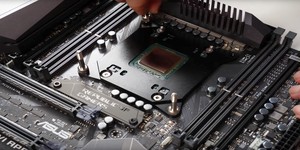Delid Die Mate looks to make Skylake de-lidding safer
November 19, 2015 | 11:41
Companies: #der8auer #haswell #overclockers-uk #roman-hartung

The Delid Die Mate, designed by Roman 'der8auer' Hartung to make de-lidding of modern processors easy and relatively safe, has now reached the UK.
Announced by designer and noted overclocker Hartung last week, the Delid Die Mate is designed to make it as easy as possible to remove the integrated heat-spreaders from modern CPUs - a necessity for extreme overclocking thanks to a shift from high-efficiency solder to lower-efficiency thermal paste between the die and the heatspreader. Typically, removing the heatspreader has been a tense process - and a shift to thinner circuit layers in Intel's latest Skylake processors makes traditional methods, including slicing the heatspreader off with a razor blade, extremely risky.
'We all know that delidding is necessary to get good scores with Skylake CPUs. I binned a lot of CPUs recently and tried to delid one of my best ones with a razor blade. However I cut a little bit too deep and damaged the CPU. CPU only runs with 8 PCIe lanes now which is a pity,' explained Hartung of the reasoning behind his design. 'So I decided to create a little tool for safe CPU delidding - I call it Delid Die Mate. The tool is pretty simple and is based on the vice method. However, CPU and heatspreader are secured inside the tool and can't move. So no risk to damage any part of the CPU. The whole delidding process takes about 1 minute with the tool. In addition you can also glue the IHS back on with the Delid Die Mate.'
Designed for Skylake processors, the tool is also compatible with Ivy Bridge, Haswell, and Devil's Canyon parts, and should work fine with Broadwell - though Hartung notes that he hasn't directly tested this model. In the UK, the gadget is being sold through Overclockers UK with pre-order pricing set at a far-from-impulse-purchase £62.99, with a protective shim frame available to prevent die-crushing of delidded chips available at an additional £27.95.
More information is available on the Overclockers UK product page, while Hartung's introduction video is reproduced below.
Announced by designer and noted overclocker Hartung last week, the Delid Die Mate is designed to make it as easy as possible to remove the integrated heat-spreaders from modern CPUs - a necessity for extreme overclocking thanks to a shift from high-efficiency solder to lower-efficiency thermal paste between the die and the heatspreader. Typically, removing the heatspreader has been a tense process - and a shift to thinner circuit layers in Intel's latest Skylake processors makes traditional methods, including slicing the heatspreader off with a razor blade, extremely risky.
'We all know that delidding is necessary to get good scores with Skylake CPUs. I binned a lot of CPUs recently and tried to delid one of my best ones with a razor blade. However I cut a little bit too deep and damaged the CPU. CPU only runs with 8 PCIe lanes now which is a pity,' explained Hartung of the reasoning behind his design. 'So I decided to create a little tool for safe CPU delidding - I call it Delid Die Mate. The tool is pretty simple and is based on the vice method. However, CPU and heatspreader are secured inside the tool and can't move. So no risk to damage any part of the CPU. The whole delidding process takes about 1 minute with the tool. In addition you can also glue the IHS back on with the Delid Die Mate.'
Designed for Skylake processors, the tool is also compatible with Ivy Bridge, Haswell, and Devil's Canyon parts, and should work fine with Broadwell - though Hartung notes that he hasn't directly tested this model. In the UK, the gadget is being sold through Overclockers UK with pre-order pricing set at a far-from-impulse-purchase £62.99, with a protective shim frame available to prevent die-crushing of delidded chips available at an additional £27.95.
More information is available on the Overclockers UK product page, while Hartung's introduction video is reproduced below.

MSI MPG Velox 100R Chassis Review
October 14 2021 | 15:04








Want to comment? Please log in.